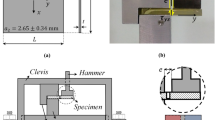Abstract
Four-point bending experiments are conceptually the method of choice when investigating the delamination strength of multi-layered components, which are of particular interest for semiconductor applications. However, experimental studies have shown that the crack continues as mode-I crack in most cases while delamination is rarely observed, thus making the four-point bending method useless. This study uses the finite element method with cohesive zones to study crack propagation and the likelihood of turning the initial mode-I crack into a delamination crack in a multi-layered structure. We close with a conclusion which can help to increase the delamination probability and thereby help to determine the delamination strengths of layered structures.








Similar content being viewed by others
Notes
The value \(r=1\) is excluded from the domain.
References
Abdul-Baqi A, van der Giessen E (2001) Indentation-induced interface delamination of a strong film on a ductile substrate. Thin Solid Films 381:143–154
Ashby F (1999) Materials Selection in Mechanical Design. Butterworth-Heinemann, Oxford
Bagchi A, Lucas GE, Suo Z, Evans AG (1994) A new procedure for measuring the decohesion energy for thin ductile films on substrates. J Mater Res 9(7):1734–1741
Brinckmann S, Van der Giessen E (2007) A fatigue crack initiation model incorporating discrete dislocation plasticity and surface roughness. Int J Fract 148(2):155–167
Brinckmann S, Siegmund T (2008) Computations of fatigue crack growth with strain gradient plasticity and an irreversible cohesive zone model. Eng Fract Mech 75(8):2276–2294
Charalambides PG, Lund J, Evans AG, McMeeking RM (1989) Test specimen for determining the fracture resistance of bimaterial interfaces. J Appl Mech, Trans ASME 56(1):77–82
Courtney TH (2005) Mechanical behavior of materials. Waveland Press, Illinois
de Boer MP, Kriese M, Gerberich WW (1997) Investigation of a new fracture mechanics specimen for thin film adhesion measurement. J Mater Res 12(10):2673–2685
Damayanti M, Widodo J, Sritharan T, Mhaisalkar SG, Lu W, Gan ZH, Zeng KY, Hsia LC (2005) Adhesion study of low-k/Si system using 4-point bending and nanoscratch test. Mater Sci Eng B 121(3):193–198
Dauskardt RH, Lane M, Ma Q, Krishna N (1998) Adhesion and debonding of multi-layer thin film structures. Eng Fract Mech 61(1):141–162
He M-Y, Hutchinson JW (1989) Kinking of a crack out of an interface. J Appl Mech 56(2):270–278
He MY, Evans AG, Hutchinson JW (1994) Crack deflection at an interface between dissimilar elastic materials: Role of residual stresses. Int J Solids Struct 31(24):3443–3455
Kriese MD, Gerberich WW, Moody NR (1999) Quantitative adhesion measures of multilayer films: Part II. indentation of W/Cu, W/W, Cr/W. J Mater Res 14:3019–3026
Lane M, Dauskardt RH, Krishna N, Hashim I (2000) Adhesion and reliability of copper interconnects with ta and TaN barrier layers. J Mater Res 15(01):203–211
Litteken CS, Strohband S, Dauskardt RH (2005) Residual stress effects on plastic deformation and interfacial fracture in thin-film structures. Acta Mater 53(7):1955–1961
Ma Q (1997) A four-point bending technique for studying subcritical crack growth in thin films and at interfaces. J Mater Res 12(3):840–845
Ma Q, Fujimoto H, Flinn P, Jain V, Adibi-Rizi F, Moghadam F, Dauskardt RH (1995) Quantitative measurement of interface fracture energy in multi-layer thin film structures. In: MRS proceedings, vol 391. Cambridge University Press, p 91
Marshall DB, Evans AG (1984) Measurement of adherence of residually stressed thin films by indentation. i. mechanics of interface delamination. J Appl Phys 56(10):2632
Matoy K, Detzel T, Müller M, Motz C, Dehm G (2009) Interface fracture properties of thin films studied by using the micro-cantilever deflection technique. Surf Coat Technol 204(6–7):878–881
Roe KL, Siegmund T (2003) An irreversible cohesive zone model for interface fatigue crack growth simulation. Eng Fract Mech 70(2):209–232
Schmitz S, Schneider-Ramelow M, Schröder S (2011) Influence of bonding process parameters on chip cratering and phase formation of Cu ball bonds on AlSiCu during storage at 200C. Microelectron Reliab 51(1):107–112 Copper Wire Bonding
Shaviv R, Roham S, Woytowitz P (2005) Optimizing the precision of the four-point bend test for the measurement of thin film adhesion. Microelectron Eng 82(2):99–112
Tran HT, Hossein Shirangi M, Pang X, Volinsky AA (2014) Temperature, moisture and mode-mixity effects on copper leadframe/emc interfacial fracture toughness. Int J Fract 185(1–2):115–127
Volinsky AA, Moody NR, Gerberich WW (2002) Interfacial toughness measurements for thin films on substrates. Acta Mater 50(3):441–466
Völker B, Heinz W, Matoy K, Roth R, Batke J-M, Schöberl T, Scheu C, Dehm G (2014) Interface fracture and chemistry of a tungsten based metallization on borophosphosilicate glass. Philos Mag 1–15. doi:10.1080/14786435.2014.913108
Wortman JJ, Evans RA (1965) Young’s modulus, shear modulus, and poisson’s ratio in silicon and germanium. J Appl Phys 36(1):153
Wurster S, Motz C, Pippan R (2012) Characterization of the fracture toughness of micro-sized tungsten single crystal notched specimens. Phil Mag 92(14):1803–1825
Xu XP, Needleman A (1994) Numerical simulations of fast crack growth in brittle solids. J Mech Phys Solids 42:1397–1434
Acknowledgments
The authors thank Prof. Reinhard Pippan for the very valuable discussions and his insight into fracture mechanics. The work of BV was jointly funded by the Austrian Research Promotion Agency (FFG, Project No. 831163) and the Carinthian Economic Promotion Fund (KWF, contact \(\hbox {KWF-1521}|22741|34186\)). The work of SB has been conducted within the project EPPL, co-funded by grants from Austria, Germany, The Netherlands, France, Italy, Portugal and the ENIAC Joint Undertaking.
Author information
Authors and Affiliations
Corresponding author
Rights and permissions
About this article
Cite this article
Brinckmann, S., Völker, B. & Dehm, G. Crack deflection in multi-layered four-point bending samples. Int J Fract 190, 167–176 (2014). https://doi.org/10.1007/s10704-014-9981-1
Received:
Accepted:
Published:
Issue Date:
DOI: https://doi.org/10.1007/s10704-014-9981-1




